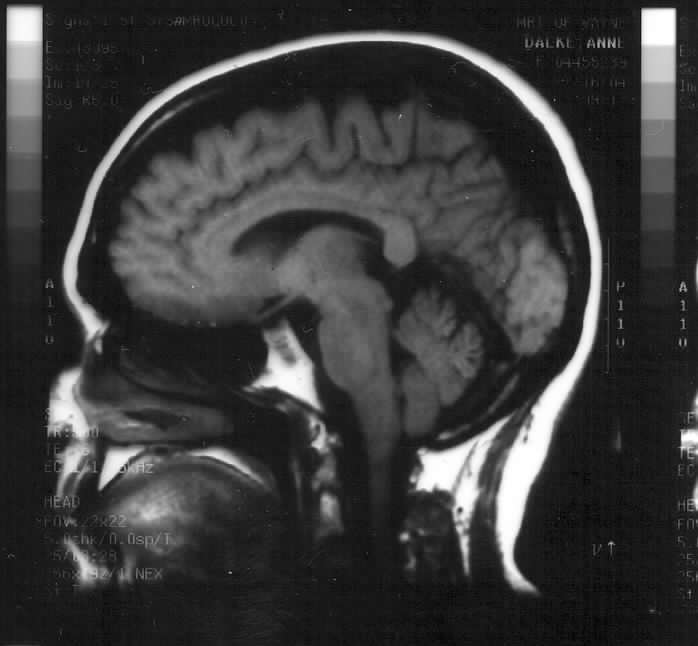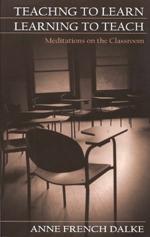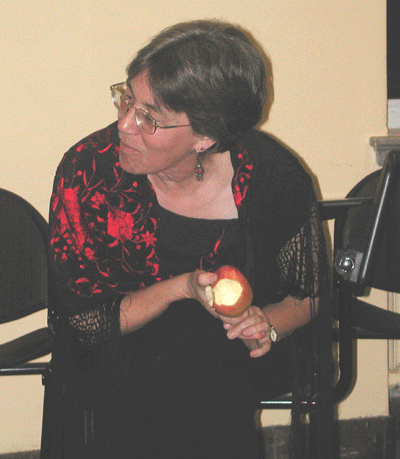

Seen this painting before? How is it different than the last time you saw it?
(In the Barnes classes, paintings are turned upside down, so viewers can see the relationship among forms,
without being distracted by what it is a picture of, what it represents....)
I asked Sharon to rotate "Interface" for me because, w/ the "squares" up top, I see echoes of
...the "neurobiologic reality" of the human brain
(courtesy of Paul Grobstein, "The Bipartite Brain...):
atop the "frog brain" sits the neocortex,
where all internal experience--feeling AND thinking--takes place
what goes on below is everything else (="being")
Sensory and motor neurons occur only in parts of the nervous system other than the neocortex.
But emotions/thoughts/experiences/stories all happen upstairs.
 Frog Brain (not to scale!) Frog Brain (not to scale!)
|  Anne's Brain (from the inside...) Anne's Brain (from the inside...) |
In "Being vs. Becoming," An Exploration included in Descartes: Being and Thinking,
Sharon made a similar distinction in watercolors:
I ...acknowledge that thinking has a role in ...'becoming'....;
for me 'being' is more an 'in the moment kind of thing.'

My own version (inspired by last week's discussion in the Emergence Working Group on the Bipartite Brain),
was more "architectural." I offered an image of

the work of trying to "make sense" of that "movement" is second order work (i.e. builds on and follows from the first).
We can learn as much as we'd like about shapes and colors, forms and angles,
but I am NOT going to find our WHY I so love that blue
(partly genetic, partly enculturated, but not dissectable or knowable in a way that has any meaning for me....)
As Barnes himself said: behind preferences we cannot go....
I was frankly surprised, on this re-reading, by Barnes' insistance on learning,
getting away from the associations to memories brought up by painting, teaching us to see its plastic form--
very different from what emerged in my section last week, as we talked about our papers:
our experiences of beauty were all related to relationships, to a feeling of connection w/ another person...
(what I just did w/ "Interface").
I'm seeing now why classrooms are so "sensorily deprived"

--
to keep us focused, to prevent distraction
Barnes, The Art in Painting: the sum total of our actual sensations is a chaos...
to be conscious of anything...we must disregard nearly all of them...
But something quite different was going on @ the Barnes Foundation:

My own (bipartite) experience at the Barnes:
- pleasure in first two galleries, at looking for the connections among the object-filled walls;
- by the third: irritation at the didactism; I felt that he was trying too hard to instruct me in a certain way...
So: my "summary" today pays attention not to the celebrators, but to the resisters (am trying to illustrate the "substance"--the importance of subjectivity--in the "form" of a provocative report, not a balanced or "objective" one):
| "Seeing is something which must be learned"
 |
"Beauty is something which must be felt";
(Dewey: "esthetic effect is found directly in sense-perception")

Dr. Anne Dalke (drawing on--> you all) |
(Also according to Dewey, this man put it all together):

William James aptly compared the course of a conscious experience to the alternate flights and perchings of a bird...Each resting place in experience is an undergoing in which is absorbed and taken home the consequences of prior doing...each doing carries in itself meaning that has been extracted and conserved...If we move too rapidly, we get away from the base of supplies--of accrued meanings....If we dawdle too long after having extracted a net value, experience perishes of inanition.
Here are (some of) the "flights" I noticed in this week's forum...
Mo:
I think that my gut reaction to Barnes is to disagree with him....I found his ideas to be too calculated and distant when art or the approciation of art and the esthetic experience seems to me to be a very personal and private experience that cannot be engineered and formulated to reach a desired end result....To be honest...Art has never really impacted me or meant much to me....I have a problem with the way that the museums are set up not only physically but also in the minds of the viewers. The art is certainly removed from its audience-there is a black line...there is this forced sense of reverance for these things on the walls....it all seems so forced. Forced to be silent, forced to take time to really try and "see" something, forced to feel something....I felt very caged in teh museum and in the ritualistic way that I was supposed to art towards these paintings.
Muska: ...at the Barnes, I immediately recognized one of the paintings as one of the pictures I used to stare at during my free period in high school....it didn't feel the same to me. I didn't feel any emotion when I saw the painting....it had to do with closeness and intimacy. In the library I was able to hold the book in my lap and trace the outlines of the brushstrokes with my fingers. I was able to hold the book up really close to my face and look at the intricate details. Even if it was just a reprint, I felt closer to it. At the museum I felt rigid and distant from the painting. I had to keep a safe distance away from all the art pieces...
Rachel:
Going to the Barnes I tried to be unattached to the paintings...I tried not associate the scenes to my own experiences.
That was a mistake....I agree with Muska that it was difficult to interact in the setting of the museum. The black tape kept me at a distant, and...having someone in the same room was a violation of my interaction with the painters' messages. On one particular occasion...I was moved. The experience was shattered however by a couple that stood beside me and applauded [another painting]....I was really frustrated that I couldn't see the beauty....Was I wrong? Uncouth? I questioned myself and the experience was lost.
Bea: ...at the Barnes, I often found it to be very difficult to focus on any of the works. When I would try to really pay attention and understand a particular piece, if felt like all the other paintings on the wall were distracting me from truly having an "experience"....I felt I had to be very aware of where I was standing at all times in relation to whichever painting I was looking at. As Muska said, there was always a security person ready to tell you to take a step back. I sometimes felt like I needed to see a painting a little closer, but I knew better. It almost felt like I had to focus more on where I was standing than what I was seeing.
Tanya: I feel that one must fully examine a piece in order to completely absorb its aesthetics, but the piece must also have "'decoration,' the immediate agreeableness of certain sensations and arrangements of sensations," to incite that desire to take a closer look....At times, I was just drawn into a piece (i.e. having a beautiful experience) that I didn't realize I had crossed the line, and the man would interrupt and ruin my moment by telling me to back up.
Eebs: ...for me, art is foreign territory....when im asked to think of art in terms of beauty, i dont know where to start.... experience (or at least mine) is composed into an experience because of all the "extraneous interuptions" of thought, gut feelings, and my blindness in regards to art.
Lauren: I really felt like I couldn't enjoy the art. I mean, I know that its beautiful, I just can't make myself learn anything from it by looking at it for a sustained period of time. I think I need a dosant; I want to learn about the art, but I want to know the stories behind it, I want someone to point out the flaws in the work and to tell me why something does or doesn't work visually. I can't be trusted to enjoy art on my own.
Does Barnes agreed? Does he trust us? Do we trust ourselves? Should we?
Catherine: I agree with Barnes that we miss the whole point of a painting if we automatically assume it is a visual reproduction of a specific subject, or telling a certain story.... Dewey defines recognition as making conscious connections from past knowledge to the present in effort to understand things. Dewey goes on to describe the idea of perception as expanding upon recognition....Barnes provides the observer with the tools necessary to form an experience out of interacting with a painting.
Dewey, "Having an Experience": Every experience...is the interaction between a live creature and some aspect of the world in which he lives....
an experience has pattern and structure...it consists of [doing and undergoing] in relationship.
Experiences are also cut short from maturing by excess of receptivity...nothing takes root in mind when there is no balance between doing and receiving...To apprehend such relations is to think....
Recognition is perception arrested before it has a chance to develop freely...In recognition we fall back, as upon a stereotype, upon some previously formed scheme...Recognition is too easy to arouse vivid consciousness. There is not enough resistance between new and old to secure consciousness of the experience....Perception is an act of the going-out of energy in order to receive...
Barnes:....an esthetic necessity: the immediacy of esthetic experience....We cannot grasp any idea...until we have felt and sensed it....Beauty...is properly an emotional term....In the presence of a...picture that lays hold of us with immediate poignancy, we are moved to ...exclaim "how beautiful." The ejaculating is a just tribute to the capacity of the object to arouse admiration....Beauty is at the furthest remove from an analytic term, and hence from...theory as a means of explanation or classification....Unfortunately, it has been hardened into a peculiar object....
it is surely better to deal with the experience itself and show whence and how the quality proceeds...beauty is the response to that which to reflection is the consummated movement of matter integrated through its inner relationship...
Reason...can never prove anything good which does not leads...to some experience valued for its own sake....in it an instinctive prompting finds fulfillment....direct impact...on the senses is very important...qualities as are immediately apprehended....We see only by utilizing the vision of others...embodied in the traditions....Each represents a systematic way of envisaging the world....either as a storehouse of instruments for the resourceful, or as a crutch for the crippled...the moment it ceases to suggest and begins to legislate, academicism sets in.
common popular misconception, a painter is often expected to tell as story...a literary or moral value is mistaken for a plastic value....we do not need to know the story to enjoy the music....Confusion of values arises only when the spectator is moved...by what he does not show him--the historical event...can produce nothing but distraction....
| Course Home Page
| Course Forum
|Science in Culture | Serendip Home |
Send us your comments at Serendip
© by Serendip 1994-
- Last Modified:
Wednesday, 02-May-2018 11:57:07 CDT











